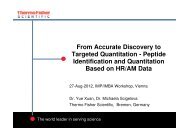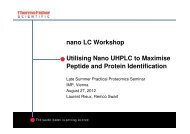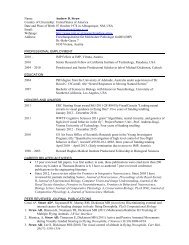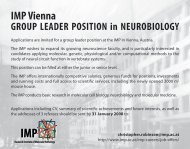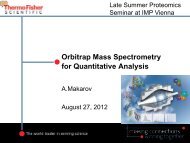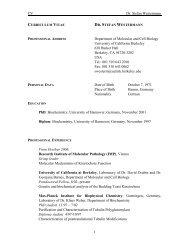IMP Research Report 2002
IMP Research Report 2002
IMP Research Report 2002
Create successful ePaper yourself
Turn your PDF publications into a flip-book with our unique Google optimized e-Paper software.
an extended conformation. Removal of higher order<br />
structural elements would allow the substrate to<br />
reinitiate folding after exit from DegP. Recruitment of<br />
PDZ domains for the gating mechanism should permit<br />
a direct coupling of substrate binding and translocation<br />
within the DegP particle. Accordingly, the PDZ domains<br />
may function as tentacular arms capturing substrates<br />
and transferring them into the inner cavity. By binding<br />
to the C-terminus or a -hairpin loop of a protein, the<br />
PDZ domains could properly position the substrate for<br />
threading it into the central cavity. After accessing this<br />
Figure 1: Top and side views of the two hexamers observed in the<br />
DegP crystals representing the open and closed form of the<br />
molecule. The individual domains are colored differently with the<br />
N-terminal domain in blue, the protease in green and the PDZ<br />
domains in yellow and red, respectively. Both hexamers are<br />
approximately equal in size having a height of 105 Å and a diameter<br />
of 120 Å.<br />
chamber, the fate of the unfolded protein depends on<br />
the interplay of several active site loops (loops LA, L1,<br />
L2, L3 using the protease nomenclature), which<br />
regulate proteolytic activity.<br />
The mobile sidewalls are constructed by twelve PDZ<br />
domains, which mediate the opening and closing of<br />
the particle and probably the initial interaction with<br />
substrate. Further binding sites for misfolded proteins<br />
are located within the inner cavity (Figure 2). Due to<br />
the geometric constraints of this chamber, substrates<br />
must be at least partially unfolded to enter. As in other<br />
chaperones of known structure, the DegP cavity is lined<br />
by hydrophobic residues. These residues form two<br />
binding platforms, which have a pronounced structural<br />
Figure 2: The internal cavity of DegP. For better illustration half cut<br />
figures of the molecular surface were prepared from both top and<br />
side views. The cutting area is shown in black. The chaperone-like<br />
features of the inner cavity are the following: (Left) Plasticity.<br />
Flexible portions are in red, whereas rigid areas are colored blue.<br />
(Middle) Hydrophobicity. The inner cavity is mainly constructed by<br />
hydrophobic residues, which are highlighted in cyan and green.<br />
(Right) Size exclusion. To illustrate the geometric restriction of the<br />
molecular compactor, a single -helix (yellow) was modeled into the<br />
cavity.<br />
flexibility as judged from their high thermal motion<br />
factors. This plasticity should allow binding of diverse<br />
polypeptides.<br />
Future studies will concentrate on the characterization<br />
of the protease form of DegP. We will aim to determine<br />
high-resolution crystal structures with substrates and<br />
Cage-forming proteases and chaperones can be<br />
energy-dependent or energy-independent. In the former<br />
group, ATPase activity is important for recognition of<br />
target proteins, their dissociation and unfolding, their<br />
translocation within the complex and various gating<br />
mechanisms. The present crystal structure indicates<br />
why these functions are not relevant for DegP. DegP<br />
preferably degrades substrates, which are per se<br />
inhibitors and extend the approach to the related DegQ<br />
and DegS proteases. The search for additional<br />
physiological substrates and for cellular effectors that<br />
either inhibit or activate members of the DegP family<br />
will contribute to our understanding of the fascinating<br />
network controlling protein composition, which is<br />
undoubtedly one of the key metabolic pathways of each<br />
cell.<br />
partially unfolded and which might accumulate under<br />
extreme conditions. Alternatively, threading of substrate<br />
through the inner chamber could promote unfolding into<br />
Contact: clausen@imp.univie.ac.at<br />
15




